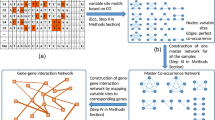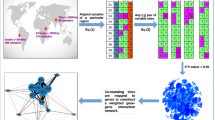Abstract
While hypoxic environment at high altitude remains a major challenge for travelers from low-altitude areas, Tibetans have adapted to the high-altitude environment. Mitochondria are the energy conversion and supplement centers in eukaryotic cells. In recent years, studies have found that the diversity of the mitochondrial genome may have a role in the adaptation to hypoxia in Tibetans. In this study, mitochondrial haplogroup classification and variant genotyping were performed in Tibetan and Han Chinese populations living at different altitudes. The frequencies of mitochondrial haplogroups B and M7 in the high-altitude population were significantly lower compared with those in the low-altitude population (P=0.003 and 0.029, respectively), whereas the frequencies of haplogroups G and M9a1a1c1b in the high-altitude group were significantly higher compared with those in the low-altitude group (P=0.01 and 0.002, respectively). The frequencies of T3394C and G7697A, which are the definition sites of haplogroup M9a1a1c1b, were significantly higher in the high-altitude group compared with that in the low-altitude group (P=0.012 and 0.02, respectively). Our results suggest that mitochondrial haplogroups B and M7 are associated with inadaptability to hypoxic environments, whereas haplogroups G and M9a1a1c1b may be associated with hypoxic adaptation. In particular, the T3394C and G7697A variants on haplogroup M9a1a1c1b may be the primary cause of adaptation to hypoxia.
Similar content being viewed by others
Log in or create a free account to read this content
Gain free access to this article, as well as selected content from this journal and more on nature.com
or
References
Bigham, A., Bauchet, M., Pinto, D., Mao, X., Akey, J. M., Mei, R. et al. Identifying signatures of natural selection in Tibetan and Andean populations using dense genome scan data. PLoS Genet. 6, e1001116 (2010).
Beall, C. M. Two routes to functional adaptation: Tibetan and Andean high-altitude natives. Proc. Natl Acad. Sci. USA 104 (suppl. 1), 8655–8660 (2007).
Leon-Velarde, F., Maggiorini, M., Reeves, J. T., Aldashev, A., Asmus, I., Bernardi, L. et al. Consensus statement on chronic and subacute high altitude diseases. High Alt. Med. Biol. 6, 147–157 (2005).
Wu, T. Life on the high Tibetan plateau. High Alt. Med. Biol. 5, 1–2 (2004).
Wu, T. The Qinghai-Tibetan plateau: how high do Tibetans live? High Alt. Med. Biol. 2, 489–499 (2001).
Beall, C. M. Andean, Tibetan, and Ethiopian patterns of adaptation to high-altitude hypoxia. Integr. Comp. Biol. 46, 18–24 (2006).
Beall, C. M., Brittenham, G. M., Strohl, K. P., Blangero, J., Williams-Blangero, S., Goldstein, M. C. et al. Hemoglobin concentration of high-altitude Tibetans and Bolivian Aymara. Am. J. Phys. Anthropol. 106, 385–400 (1998).
Moore, L. G. Human genetic adaptation to high altitude. High Alt. Med. Biol. 2, 257–279 (2001).
Wu, T., Wang, X., Wei, C., Cheng, H., Wang, X., Li, Y. et al. Hemoglobin levels in Qinghai-Tibet: different effects of gender for Tibetans vs. Han. J. Appl. Physiol. 98, 598–604 (2005).
Schon, E. A., DiMauro, S. & Hirano, M. Human mitochondrial DNA: roles of inherited and somatic variants. Nat. Rev. Genet. 13, 878–890 (2012).
Andrews, R. M., Kubacka, I., Chinnery, P. F., Lightowlers, R. N., Turnbull, D. M., Howell, N. et al. Reanalysis and revision of the Cambridge reference sequence for human mitochondrial DNA. Nat. Genet. 23, 147 (1999).
Luo, Y., Gao, W., Liu, F. & Gao, Y. Mitochondrial nt3010G-nt3970C haplotype is implicated in high-altitude adaptation of Tibetans. Mitochondrial DNA 22, 181–190 (2011).
Ji, F., Sharpley, M. S., Derbeneva, O., Alves, L. S., Qian, P., Wang, Y. et al. Mitochondrial DNA variant associated with Leber hereditary optic neuropathy and high-altitude Tibetans. Proc. Natl Acad. Sci. USA 109, 7391–7396 (2012).
Gu, M., Dong, X., Shi, L., Shi, L., Lin, K., Huang, X. et al. Differences in mtDNA whole sequence between Tibetan and Han populations suggesting adaptive selection to high altitude. Gene 496, 37–44 (2012).
Zhang, A. M., Jia, X., Bi, R., Salas, A., Li, S., Xiao, X. et al. Mitochondrial DNA haplogroup background affects LHON, but not suspected LHON, in Chinese patients. PLoS ONE 6, e27750 (2011).
van Oven, M. & Kayser, M. Updated comprehensive phylogenetic tree of global human mitochondrial DNA variation. Hum. Mutat. 30, E386–E394 (2009).
Fan, L. & Yao, Y. G. MitoTool: a web server for the analysis and retrieval of human mitochondrial DNA sequence variations. Mitochondrion 11, 351–356 (2010).
Qin, Z., Yang, Y., Kang, L., Yan, S., Cho, K., Cai, X. et al. A mitochondrial revelation of early human migrations to the Tibetan Plateau before and after the last glacial maximum. Am. J. Phys. Anthropol. 143, 555–569 (2010).
Yao, Y. G., Kong, Q. P., Bandelt, H. J., Kivisild, T. & Zhang, Y. P. Phylogeographic differentiation of mitochondrial DNA in Han Chinese. Am. J. Hum. Genet. 70, 635–651 (2002).
Li, F. X., Ji, F. Y., Zheng, S. Z., Yao, W., Xiao, Z. L. & Qian, G. S. MtDNA haplogroups M7 and B in southwestern Han Chinese at risk for acute mountain sickness. Mitochondrion 11, 553–558 (2011).
Liu, Y. J., Gao, W. X., Li, S. Z., Huang, X. W., Chen, Y., Liu, F. Y. et al. Mitochondrial haplogroup D4 confers resistance and haplogroup B is a genetic risk factor for high-altitude pulmonary edema among Han Chinese. Genet. Mol. Res 11, 3658–3667 (2012).
Soares, P., Trejaut, J. A., Loo, J. H., Hill, C., Mormina, M., Lee, C. L. et al. Climate change and postglacial human dispersals in southeast Asia. Mol. Biol. Evol. 25, 1209–1218 (2008).
Tabbada, K. A., Trejaut, J., Loo, J. H., Chen, Y. M., Lin, M., Mirazón-Lahr, M. et al. Philippine mitochondrial DNA diversity: a populated viaduct between Taiwan and Indonesia? Mol. Biol. Evol. 27, 21–31 (2009).
Torroni, A., Miller, J. A., Moore, L. G., Zamudio, S., Zhuang, J., Droma, T. et al. Mitochondrial DNA analysis in Tibet: implications for the origin of the Tibetan population and its adaptation to high altitude. Am. J. Phys. Anthropol. 93, 189–199 (1994).
Yao, Y. G., Kong, Q. P., Wang, C. Y., Zhu, C. L. & Zhang, Y. P. Different matrilineal contributions to genetic structure of ethnic groups in the silk road region in China. Mol. Biol. Evol. 21, 2265–2280 (2004).
Zhao, M., Kong, Q. P., Wang, H. W., Peng, M. S., Xie, X. D., Wang, W. Z. et al. Mitochondrial genome evidence reveals successful Late Paleolithic settlement on the Tibetan Plateau. Proc. Natl Acad. Sci. USA 106, 21230–21235 (2009).
Brown, M. D., Torroni, A., Reckord, C. L. & Wallace, D. C. Phylogenetic analysis of Leber's hereditary optic neuropathy mitochondrial DNA's indicates multiple independent occurrences of the common variants. Hum. Mutat. 6, 311–325 (1995).
Liang, M., Guan, M., Zhao, F., Zhou, X., Yuan, M., Tong, Y. et al. Leber's hereditary optic neuropathy is associated with mitochondrial ND1 T3394C variant. Biochem Biophys. Res. Commun. 383, 286–292 (2009).
Liu, S. M., Zhou, X., Zheng, F., Li, X., Liu, F., Zhang, H. M. et al. Novel variants found in mitochondrial diabetes in Chinese Han population. Diabetes Res. Clin. Pract. 76, 425–435 (2007).
Puomila, A., Hamalainen, P., Kivioja, S., Savontaus, M. L., Koivumaki, S., Huoponen, K. et al. Epidemiology and penetrance of Leber hereditary optic neuropathy in Finland. Eur. J. Hum. Genet. 15, 1079–1089 (2007).
Acknowledgements
We are grateful to the participants of this study. The study was supported by the National Natural Science Foundation of China (No. 30971578) and the Chinese National High Technology Research and Development Program (No. 2012AA021802).
Author information
Authors and Affiliations
Corresponding authors
Ethics declarations
Competing interests
The authors declare no conflict of interest.
Additional information
Supplementary Information accompanies the paper on Journal of Human Genetics website
Supplementary information
Rights and permissions
About this article
Cite this article
Li, Q., Lin, K., Sun, H. et al. Mitochondrial haplogroup M9a1a1c1b is associated with hypoxic adaptation in the Tibetans. J Hum Genet 61, 1021–1026 (2016). https://doi.org/10.1038/jhg.2016.95
Received:
Revised:
Accepted:
Published:
Issue date:
DOI: https://doi.org/10.1038/jhg.2016.95
This article is cited by
-
Association of variants m.T16172C and m.T16519C in whole mtDNA sequences with high altitude pulmonary edema in Han Chinese lowlanders
BMC Pulmonary Medicine (2022)
-
Analysis of human mitochondrial genome co-occurrence networks of Asian population at varying altitudes
Scientific Reports (2021)
-
Mitochondrial DNA genomes revealed different patterns of high-altitude adaptation in high-altitude Tajiks compared with Tibetans and Sherpas
Scientific Reports (2020)
-
Mitochondrial DNA sequencing reveals association of variants and haplogroup M33a2′3 with High altitude pulmonary edema susceptibility in Indian male lowlanders
Scientific Reports (2019)
-
Correlations between gut microbiota community structures of Tibetans and geography
Scientific Reports (2017)



